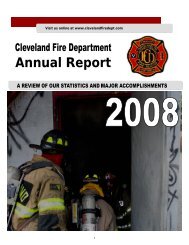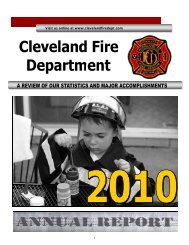SOP Manual - Cleveland Fire Department
SOP Manual - Cleveland Fire Department
SOP Manual - Cleveland Fire Department
- No tags were found...
Create successful ePaper yourself
Turn your PDF publications into a flip-book with our unique Google optimized e-Paper software.
<strong>Cleveland</strong> <strong>Fire</strong> <strong>Department</strong><br />
Operations <strong>Manual</strong><br />
B. Command’s Response to MAYDAY<br />
Upon receipt/recognition of a MAYDAY, Command shall notify Communications via the fire<br />
tactical channel. Communications shall immediately transmit an alert tone followed by a verbal<br />
message on the tactical channel and fire dispatch channel indicating that a MAYDAY has been<br />
transmitted. The Communications Center will immediately advise all personnel that all nonemergency<br />
radio traffic must cease. There should not be any delay in controlling fire ground<br />
tactical channel once a MAYDAY has been called. Only traffic pertinent to the MAYDAY shall<br />
be permitted on the tactical channel until a separate radio channel is assigned for the rescue<br />
operation (if needed). All non-emergency activity will cease on all fire channels, and all channels<br />
shall be monitored closely for any transmissions by the missing firefighter(s).<br />
C. <strong>Fire</strong>fighter’s Responsibilities<br />
<strong>Fire</strong>fighters must not hesitate to declare a MAYDAY if they become lost, trapped, disoriented<br />
and/or in need of assistance.<br />
This should occur as soon as the individual thinks that he/she may be in trouble. Upon recognition<br />
that a MAYDAY situation exists, the firefighter should activate his/her PASS device manually to<br />
sound an audible alarm. The device should remain active until members of the RIT reach the<br />
member(s) or the member(s) is able to reach safety. If the device interferes with radio<br />
communications, it may be turned off temporarily, but must be re-activated to sound the audible<br />
alarm. Lost or trapped crew(s) shall remain together.<br />
Lost or trapped firefighter(s) should always attempt to get out of a building by whatever means<br />
possible. A conscious effort must be made by the trapped firefighter(s) to control breathing and<br />
remain calm. Unnecessary talking or physical activity must cease to increase the likelihood of<br />
extending the supply of air until rescuers can locate the trapped member(s). In assuming a<br />
position to wait for rescuers, the firefighter(s) should attempt to position a flashlight(s) towards the<br />
ceiling. This may enhance the rescuers ability locate their position.<br />
Where doors, windows or other egress are not available, firefighters should attempt to reach an<br />
exterior wall. Once at the wall, a search for doorways, windows and hallways will generally lead<br />
to the outside. Rescuers will first search hallways, around walls, and around windows and doors<br />
before sweeping large interior areas. Where a firefighter(s) cannot find a way out, but there is safe<br />
refuge (protective room or floor) away from the fire to which the firefighter(s) can retreat, he<br />
should take advantage of this location. Command and rescuers should then be advised of the<br />
location by whatever means possible.<br />
Tactical Positioning<br />
Positioning of operating companies can severely affect the safety/survival of such companies. Personnel<br />
must use caution when placed in the following positions:<br />
A. Above the fire (floors/roof).<br />
B. Where the fire can move in behind them.<br />
C. When involved with opposing fire streams.<br />
D. Combining interior and exterior attack.<br />
Effective: June 1, 1997 Revised: 5/14/2009 Page | 275<br />
Approved by: Chief Chuck Atchley




